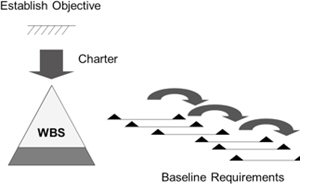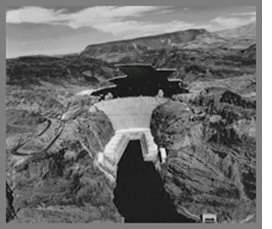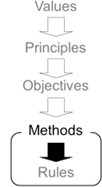Level 2 Management
The centerpiece of Level 2 Management is the methodology. This is comprised
of a Charter, a Work Breakdown Structure, and baseline requirements with schedule
and cost factors detailed. The Charter is in essence a contract with stakeholders.
It positions authority for stewardship of all that is required with a Manager,
a Project Manager. The Work Breakdown Structure confronts detail complexity, allowing
you to disintegrate the prospect into sub elements and, thereby, "eat the elephant
one bite at a time."
 The major
challenge to a good methodology is risk — the chance that something may not
go according to plan. In anticipation of adversity, statistics provide a basis
for assessing the probability of a reasonably possible adverse event and the potential
exposure should that event occur. Multiplying the two provides a basis for a risk
contingency that is then added to the estimate in advance of the implementation.
A risk registry becomes the project manager's tool for soldiering forward against
adversity. In fact, with the highly predictable environment of Level 2 management,
prescribed contingency plans are put in place just in case and, should the need
arise, they are pulled off the shelf, dusted off, and put into action. The major
challenge to a good methodology is risk — the chance that something may not
go according to plan. In anticipation of adversity, statistics provide a basis
for assessing the probability of a reasonably possible adverse event and the potential
exposure should that event occur. Multiplying the two provides a basis for a risk
contingency that is then added to the estimate in advance of the implementation.
A risk registry becomes the project manager's tool for soldiering forward against
adversity. In fact, with the highly predictable environment of Level 2 management,
prescribed contingency plans are put in place just in case and, should the need
arise, they are pulled off the shelf, dusted off, and put into action.
At some point through the course of the project, the final configuration of
the product comes into focus. With that, the configuration is documented and the
initiative reduces to a Level 1 management model for its operating phase.
The Hoover Dam Project Example
 The Hoover
Dam remains a great wonder in engineering and construction, attracting tourists
for the better part of a century. The project was funded by the Federal Government
of the United States as part of the infrastructure push post-depression. Construction
began in 1933. Of course, you do not just run in, pour four million tons of concrete,
and call it a day. There is a river in the way, there are no workers on site ...
and so the organizing archetype of classical project management is employed to
reduce the exercise to a methodology. There are no rules for building a dam, no
mass production, no building and then discarding. It has to be right the first
time! The Hoover
Dam remains a great wonder in engineering and construction, attracting tourists
for the better part of a century. The project was funded by the Federal Government
of the United States as part of the infrastructure push post-depression. Construction
began in 1933. Of course, you do not just run in, pour four million tons of concrete,
and call it a day. There is a river in the way, there are no workers on site ...
and so the organizing archetype of classical project management is employed to
reduce the exercise to a methodology. There are no rules for building a dam, no
mass production, no building and then discarding. It has to be right the first
time!
 On the upside,
we know what the physical terrain is. Our forbearers have studied soil, rock,
concrete and steel ad infinitum. Though the initiative is spectacular — large
scale — the prospect is also stable. This is not trial-and-error high tech
development. If we can attack the detail complexity issue through a work breakdown
structure, have a master project plan with a Manager responsible for devolution
of sub tasks through a Responsibility Assignment Matrix; our dam will come together
roughly as predicted. While, we need to move that river out of the way, blast
bed rock and take care of some other details, but with a stable methodology in
place, we should be able to plan the work and then work the plan to bring the
project to a successful end. On the upside,
we know what the physical terrain is. Our forbearers have studied soil, rock,
concrete and steel ad infinitum. Though the initiative is spectacular — large
scale — the prospect is also stable. This is not trial-and-error high tech
development. If we can attack the detail complexity issue through a work breakdown
structure, have a master project plan with a Manager responsible for devolution
of sub tasks through a Responsibility Assignment Matrix; our dam will come together
roughly as predicted. While, we need to move that river out of the way, blast
bed rock and take care of some other details, but with a stable methodology in
place, we should be able to plan the work and then work the plan to bring the
project to a successful end.
In the civil engineering world in general, the stability of infrastructure
enables stability of methods. Projects are so predictable that they are often
awarded through a competitive tender. Low bid wins. The Hoover Dam was awarded
to a consortium of five companies that united to call themselves "Five Companies".
For $50B, they established a base camp, moved the river, poured the concrete and
turned on the power, all within a five-year construction period!
|



